dolphin's
Taxonomy
- Suborder Odontoceti, toothed whales
- Family Delphinidae, oceanic dolphins
- Genus Delphinus
- Long-Beaked Common Dolphin, Delphinus capensis
- Short-Beaked Common Dolphin, Delphinus delphis
- Genus Tursiops
- Common Bottlenose Dolphin, Tursiops truncatus
- Indo-Pacific Bottlenose Dolphin, Tursiops aduncus
- Burrunan Dolphin, Tursiops australis, a new discovered species from sea aroundMelbourne in September 2011.[8]
- Genus Lissodelphis
- Northern Rightwhale Dolphin, Lissodelphis borealis
- Southern Rightwhale Dolphin, Lissodelphis peronii
- Genus Sotalia
- Genus Sousa
- Indo-Pacific Hump-backed Dolphin, Sousa chinensis
- Chinese White Dolphin (the Chinese variant), Sousa chinensis chinensis
- Atlantic Humpbacked Dolphin, Sousa teuszii
- Indo-Pacific Hump-backed Dolphin, Sousa chinensis
- Genus Stenella
- Atlantic Spotted Dolphin, Stenella frontalis
- Clymene Dolphin, Stenella clymene
- Pantropical Spotted Dolphin, Stenella attenuata
- Spinner Dolphin, Stenella longirostris
- Striped Dolphin, Stenella coeruleoalba
- Genus Steno
- Rough-Toothed Dolphin, Steno bredanensis
- Genus Cephalorhynchus
- Chilean Dolphin, Cephalorhynchus eutropia
- Commerson's Dolphin, Cephalorhynchus commersonii
- Heaviside's Dolphin, Cephalorhynchus heavisidii
- Hector's Dolphin, Cephalorhynchus hectori
- Genus Grampus
- Risso's Dolphin, Grampus griseus
- Genus Lagenodelphis
- Fraser's Dolphin, Lagenodelphis hosei
- Genus Lagenorhynchus
- Atlantic White-Sided Dolphin, Lagenorhynchus acutus
- Dusky Dolphin, Lagenorhynchus obscurus
- Hourglass Dolphin, Lagenorhynchus cruciger
- Pacific White-Sided Dolphin, Lagenorhynchus obliquidens
- Peale's Dolphin, Lagenorhynchus australis
- White-Beaked Dolphin, Lagenorhynchus albirostris
- Genus Orcaella
- Australian Snubfin Dolphin, Orcaella heinsohni
- Irrawaddy Dolphin, Orcaella brevirostris
- Genus Peponocephala
- Melon-headed Whale, Peponocephala electra
- Genus Orcinus
- Killer Whale (Orca), Orcinus orca
- Genus Feresa
- Pygmy Killer Whale, Feresa attenuata
- Genus Pseudorca
- False Killer Whale, Pseudorca crassidens
- Genus Globicephala
- Long-finned Pilot Whale, Globicephala melas
- Short-finned Pilot Whale, Globicephala macrorhynchus
- Genus †Australodelphis
- Genus Delphinus
- Family Platanistidae
- Ganges and Indus River Dolphin, Platanista gangetica with two subspecies
- Ganges River Dolphin (or Susu), Platanista gangetica gangetica
- Indus River Dolphin (or Bhulan), Platanista gangetica minor
- Ganges and Indus River Dolphin, Platanista gangetica with two subspecies
- Family Iniidae
- Amazon River Dolphin (or Boto), Inia geoffrensis
- Family Lipotidae
- Baiji (or Chinese River Dolphin), Lipotes vexillifer (possibly extinct, since December 2006)
- Family Pontoporiidae
- La Plata Dolphin (or Franciscana), Pontoporia blainvillei
- Family Delphinidae, oceanic dolphins
Six species in the family Delphinidae are commonly called "whales", but genetically are dolphins. They are sometimes called blackfish.
- Melon-headed Whale, Peponocephala electra
- Killer Whale (Orca), Orcinus orca
- Pygmy Killer Whale, Feresa attenuata
- False Killer Whale, Pseudorca crassidens
- Long-finned Pilot Whale, Globicephala melas
- Short-finned Pilot Whale, Globicephala macrorhynchus
Hybridization
In 1933, three strange dolphins beached off the Irish coast; they appeared to be hybrids betweenRisso's and bottlenose dolphins.[9] This mating was later repeated in captivity, producing a hybrid calf. In captivity, a bottlenose and a rough-toothed dolphin produced hybrid offspring.[10] A common-bottlenose hybrid lives at SeaWorld California.[11] Other dolphin hybrids live in captivity around the world or have been reported in the wild, such as a bottlenose-Atlantic spotted hybrid.[12] The best known hybrid is the wolphin, a false killer whale-bottlenose dolphin hybrid. The wolphin is a fertile hybrid. Two wolphins currently live at the Sea Life Park in Hawaii; the first was born in 1985 from a male false killer whale and a female bottlenose. Wolphins have also been observed in the wild.[13]
Evolution and anatomy
Evolution
See also: Evolution of cetaceans
Dolphins, along with whales and porpoises, are descendants of terrestrial mammals, most likely of the Artiodactyl order. The ancestors of the modern-day dolphins entered the water roughly 50 million years ago, in the Eocene epoch.
Modern dolphin skeletons have two small, rod-shaped pelvic bones thought to bevestigial hind limbs. In October 2006, an unusual bottlenose dolphin was captured inJapan; it had small fins on each side of its genital slit, which scientists believe to be a more pronounced development of these vestigial hind limbs.[14]
Anatomy
Dolphins have a streamlined fusiform body, adapted for fast swimming. The tail fin, called the fluke, is used for propulsion, while the pectoral fins together with the entire tail section provide directional control. The dorsal fin, in those species that have one, provides stability while swimming. Though it varies by species, basic coloration patterns are shades of grey, usually with a lighter underside, often with lines and patches of different hue and contrast.
The head contains the melon, a round organ used for echolocation. In many species, elongated jaws form a distinct beak; species such as the bottlenose have a curved mouth which looks like a fixed smile. Some species have up to 250 teeth. Dolphins breathe through a blowhole on top of their head. The trachea is anterior to the brain. The dolphin brain is large and highly complex, and is different in structure from that of most land mammals.
Unlike most mammals, dolphins do not have hair, except for a few hairs around the tip of theirrostrum which they lose shortly before or after birth.[15] The only exception to this is the Boto river dolphin, which has persistent small hairs on the rostrum.[16]
Dolphins' reproductive organs are located on the underside of the body. Males have two slits, one concealing the penis and one further behind for the anus. The female has one genital slit, housing thevagina and the anus. Two mammary slits are positioned on either side of the female's genital slit.
Though the exact methods used to achieve this are not known, dolphins can tolerate and recover from extreme injuries, such as shark bites. The healing process is rapid and even very deep wounds do not cause dolphins to hemorrhage to death. Furthermore, even gaping wounds restore in such a way that the animal's body contour is restored, and infection of such large wounds seems rare.[17]
A study at the U.S. National Marine Mammal Foundation revealed that dolphins, like humans, develop a natural form of type 2 diabetes, which may lead to a better understanding of the disease and new treatments for both humans and dolphins.[18]
Senses
Most dolphins have acute eyesight, both in and out of the water, and they can hear frequencies ten times or more above the upper limit of adult human hearing.[19] Though they have a small ear opening on each side of their head, it is believed hearing underwater is also, if not exclusively, done with the lower jaw, which conducts sound to the middle ear via a fat-filled cavity in the lower jaw bone. Hearing is also used forecholocation, which all dolphins have. Dolphin teeth are believed to function as antennae to receive incoming sound and to pinpoint the exact location of an object.[20] Beyond locating an object, echolocation also provides the animal with an idea on the object's shape and size, though how exactly this works is not yet understood.[21] The Indus Dolphin is effectively blind. This may be because not much light penetrates the waters of the Indus river (due to suspended sediments), making eyes futile.[22]
The dolphin's sense of touch is also well-developed, with free nerve endings densely packed in the skin, especially around the snout, pectoral fins and genital area. However, dolphins lack an olfactory nerve and lobes, and thus are believed to have no sense of smell.[23] They do have a sense of taste and show preferences for certain kinds of fish. Since dolphins spend most of their time below the surface, tasting the water could function like smelling, in that substances in the water can signal the presence of objects that are not in the dolphin’s mouth.
Though most dolphins do not have hair, they do have hair follicles that may perform some sensory function.[24] The small hairs on the rostrum of the Boto river dolphin are believed to function as a tactile sense possibly to compensate for the Boto's poor eyesight.[25]
Behavior
See also: Whale surfacing behaviour
Dolphins are often regarded as one of Earth's most intelligent animals, though it is hard to say just how intelligent. Comparing species' relative intelligence is complicated by differences in sensory apparatus, response modes, and nature of cognition. Furthermore, the difficulty and expense of experimental work with large aquatic animals has so far prevented some tests and limited sample size and rigor in others. Compared to many other species, however, dolphin behavior has been studied extensively, both in captivity and in the wild. See cetacean intelligence for more details.
Social behavior
Dolphins are social, living in pods of up to a dozen individuals. In places with a high abundance of food, pods can merge temporarily, forming a superpod; such groupings may exceed 1,000 dolphins. Individuals communicate using a variety of clicks, whistles-like sounds and other vocalizations. Membership in pods is not rigid; interchange is common. However, dolphins can establish strong social bonds; they will stay with injured or ill individuals, even helping them to breathe by bringing them to the surface if needed.[26] This altruism does not appear to be limited to their own species however. The dolphin Moko in New Zealand has been observed guiding a female Pygmy Sperm Whale together with her calf out of shallow water where they had stranded several times.[27] They have also been seen protecting swimmers from sharks by swimming circles around the swimmers[28][29] or charging the sharks to make them go away.[30]
Dolphins also display culture, something long believed to be unique to humans (and possibly otherprimate species). In May 2005, a discovery in Australia found Indo-Pacific bottlenose dolphins(Tursiops aduncus) teaching their young to use tools. They cover their snouts with sponges to protect them while foraging. This knowledge is mostly transferred by mothers to daughters, unlikesimian primates, where knowledge is generally passed on to both sexes. Using sponges as mouth protection is a learned behavior.[31] Another learned behavior was discovered among river dolphins in Brazil, where some male dolphins use weeds and sticks as part of a sexual display.[32]
Dolphins engage in acts of aggression towards each other. The older a male dolphin is, the more likely his body is to be covered with bite scars. Male dolphins engage in such acts of aggression apparently for the same reasons as humans: disputes between companions and competition for females. Acts of aggression can become so intense that targeted dolphins sometimes go into exile as a result of losing a fight.
Male bottlenose dolphins have been known to engage in infanticide. Dolphins have also been known to kill porpoises for reasons which are not fully understood, as porpoises generally do not share the same diet as dolphins, and are therefore not competitors for food supplies.[33]
Reproduction and sexuality
Dolphin copulation happens belly to belly; though many species engage in lengthy foreplay, the actual act is usually brief, but may be repeated several times within a short timespan. The gestation period varies with species; for the small Tucuxi dolphin, this period is around 11 to 12 months, while for the orca, the gestation period is around 17 months. Typically dolphins give birth to a single calf, which is, unlike most other mammals, born tail first in most cases.[34] They usually become sexually active at a young age, even before reaching sexual maturity. The age of sexual maturity varies by species and gender.
Dolphins are known to have sex for reasons other than reproduction[citation needed], sometimes also engaging in homosexual behavior. Various species sometimes engage in sexual behavior including copulation with other dolphin species. Sexual encounters may be violent, with male dolphins sometimes showing aggressive behavior towards both females and other males.[35] Occasionally, dolphins behave sexually towards other animals, including humans.[36]
Feeding
Various methods of feeding exist among and within species, some apparently exclusive to a single population. Fish and squid are the main food, but the false killer whale and the orca also feed on other marine mammals.
One common feeding method is herding, where a pod squeezes a school of fish into a small volume, known as a bait ball. Individual members then take turns plowing through the ball, feeding on the stunned fish. Coralling is a method where dolphins chase fish into shallow water to catch them more easily. In South Carolina, the Atlantic bottlenose dolphin takes this further with "strand feeding", driving prey onto mud banks for easy access.[37] In some places, orcas come to the beach to capture sea lions. Some species also whack fish with their flukes, stunning them and sometimes knocking them out of the water.
Reports of cooperative human-dolphin fishing date back to the ancient Roman author and natural philosopher Pliny the Elder.[38] A modern human-dolphin partnership currently operates in Laguna, Santa Catarina, Brazil. Here, dolphins drive fish towards fishermen waiting along the shore and signal the men to cast their nets. The dolphins’ reward is the fish that escape the nets.[39][40]
Vocalizations
Dolphins are capable of making a broad range of sounds using nasal airsacs located just below the blowhole. Roughly three categories of sounds can be identified:frequency modulated whistles, burst-pulsed sounds and clicks. Dolphins communicate with whistle-like sounds produced by vibrating connective tissue, similar to the way human vocal cords function,[41] and through burst-pulsed sounds, though the nature and extent of that ability is not known. The clicks are directional and are for echolocation, often occurring in a short series called a click train. The click rate increases when approaching an object of interest. Dolphin echolocation clicks are amongst the loudest sounds made by marine animals.[42]
In 2011 researchers in the United States and Great Britain, using a CymaScope — an instrument which produces visible patterns from sound — have found that part of dolphin communication consists of receiving and transmitting sound pictures. It is almost certain that to some extent this ability is shared by the entire dolphin family.[43]
Jumping and playing
Dolphins occasionally leap above the water surface, and sometimes perform acrobatic figures (for example, the spinner dolphin). Scientists are not certain about the purpose(s) of the acrobatics. Possibilities include locating schools of fish by looking at above-water signs like feeding birds, communicating with other dolphins, dislodging parasites or simple amusement.
Play is an important part of dolphin culture. Dolphins play with seaweed and play-fight with other dolphins. At times they harass other local creatures, like seabirds and turtles. Dolphins enjoy riding waves and frequently surf coastal swells and the bow waves of boats, at times “leaping” between the dual bow waves of a moving catamaran. Occasionally, they playfully interact with swimmers. Captive dolphins have been observed in aquariums engaging in complex play behavior which involves the creation and manipulation of bubble rings.[44][45][46][47]
Sleeping
Further information: Sleep (non-human)
Generally, dolphins sleep with only one brain hemisphere in slow-wave sleep at a time, thus maintaining enough consciousness to breathe and to watch for possible predators and other threats. Earlier sleep stages can occur simultaneously in both hemispheres.[48][49][50] In captivity, dolphins seemingly enter a fully asleep state where both eyes are closed and there is no response to mild external stimuli. In this case, respiration is automatic; a tail kick reflexkeeps the blowhole above the water if necessary. Anesthetized dolphins initially show a tail kick reflex.[51] Though a similar state has been observed with wild sperm whales, it is not known if dolphins in the wild reach this state.[52] The Indus river dolphin has a sleep method that is different from that of other dolphin species. Living in water with strong currents and potentially dangerous floating debris, it must swim continuously to avoid injury. As a result, this species sleeps in very short bursts which last between 4 and 60 seconds.[53]
Threats
Natural threats
Except for humans (discussed below), dolphins have few natural enemies. Some species or specific populations have none, making them apex predators. For most of the smaller species of dolphins, only a few of the larger sharks, such as the bull shark, dusky shark, tiger shark andgreat white shark, are a potential risk, especially for calves. Some of the larger dolphinic species, especially orcas (killer whales), may also prey on smaller dolphins, but this seems rare. Dolphins also suffer from a wide variety of diseases and parasites.[citation needed]
Human threats
See also: Dolphin drive hunting and Cetacean bycatch
Some dolphin species face an uncertain future, especially some river dolphin species such as the Amazon river dolphin, and the Ganges and Yangtze river dolphin, which are critically or seriously endangered. A 2006 survey found no individuals of the Yangtze river dolphin, which now appears to befunctionally extinct.[54]
Pesticides, heavy metals, plastics, and other industrial and agricultural pollutants that do not disintegrate rapidly in the environment concentrate in predators such as dolphins.[55] Injuries or deaths due to collisions with boats, especially their propellers, are also common.
Various fishing methods, most notably purse seine fishing for tuna and the use of drift and gill nets, unintentionally kill many dolphins.[56] Accidental by-catch in gill nets and incidental captures in antipredator nets that protect marine fish farms are common and pose a risk for mainly local dolphin populations.[57][58] In some parts of the world, such as Taiji in Japan and the Faroe Islands, dolphins are traditionally considered as food, and are killed in harpoon or drive hunts.[59] Dolphin meat is high in mercury, and may thus pose a health danger to humans when consumed.[60]
Dolphin safe labels attempt to reassure consumers fish and other marine products have been caught in a dolphin-friendly way. The original deal with "Dolphin safe" labels was brokered in the 1980s between marine activists and the major tuna companies, and involved decreasing incidental dolphin kills by up to 50% by changing the type of nets being used to catch the tuna. It should be noted that the dolphins are netted only while fishermen are in pursuit of smaller tuna. Albacore are not netted this way, making albacore the only truly dolphin-safe tuna.[citation needed]
Loud underwater noises, such as those resulting from naval sonar use, live firing exercises, or certain offshore construction projects, such aswind farms, may be harmful to dolphins, increasing stress, damaging hearing, and causing decompression sickness by forcing them to surface too quickly to escape the noise.[61][62]
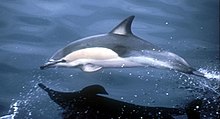






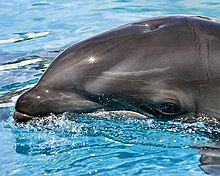






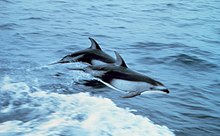
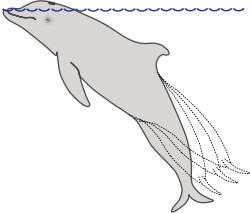
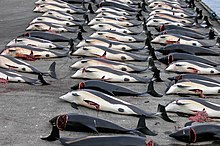
Tidak ada komentar:
Posting Komentar